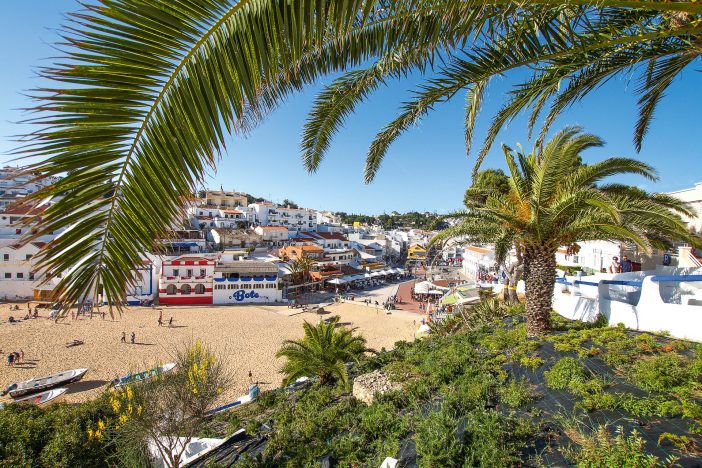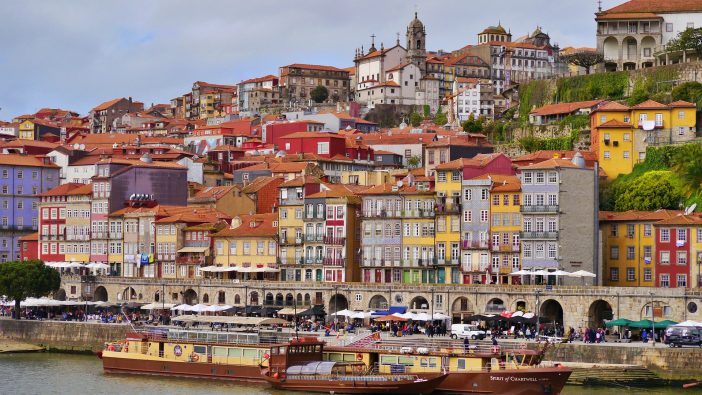In this post, we will take a journey from the north to the south of Portugal. Although Lisbon is the most popular city to visit, there is a lot of other beautiful destinations in the country.
Algarve
The Algarve in the south of Portugal is a top holiday destination. Most of the time the weather is fine and you can enjoy sunny days nearly all year round. You will find the best beaches of golden sand with stunning cliffs and sapphire crystal Atlantic water here. There are more than 100 beaches in the Algarve and many of them have won awards. Though going to the Algarve people tend to have only the beach in mind this region also has beautiful castle ruins, museums, and old cathedrals. A couple of the most important cultural landmarks you will find in the historic centers of Faro and Lagos – the two main cities of the region.

Alentejo
If you want to experience authentic Portuguese culture, cuisine and nature, Alentejo is the place to go. The Alentejo is the biggest region in Portugal between Lisbon and the Algarve. This region is full of history, amazing landscapes, and a beautiful coastline of quiet beaches. This is Portugal’s garden with vast olive groves, vineyards and cork trees. The region includes some of the best natural parks in the country with hiking trails.
Évora is the main city of Alentejo. The historic city center with Roman ruins and Gothic churches is considered a World Heritage Site by UNESCO, since 1986. Some landmarks include the Temple of Diana, the Silver Water Roman Aqueduct, the Chapel of Bones inside the Saint Francisco Church and Évora Cathedral ( Sé de Évora) – the largest medieval cathedral in Portugal.
Coimbra
Coimbra, located in central Portugal, was the second Portuguese capital up until 1255 when it was replaced by Lisbon. The city is famous for its university – the oldest in the country and one of the oldest in Europe and a fantastic collection of old churches, monasteries and impressive edifices.
The University of Coimbra is the most popular tourist attraction and a World Heritage Site. Originally a medieval palace, over the centuries, Baroque and neo-classical features have been added to the university. Located on a hill in the center of the city it has a beautiful view over Coimbra. On the way downhill from the university you will also pass the 12th century The Old Cathedral of Coimbra (Sé Velha Cathedral), the 16th century The Sub-Ripas Palace (Palácio de Sub-Ripas) and the 12th century The Santa Cruz Monastery best known as Igreja (Church) de Santa Cruz.
Botanical Garden – another landmark and, definitely, worth a visit. It is the largest botanical garden in Portugal and home to over 1200 different species of plants and trees.

Porto
Porto is the second largest city in Portugal, known worldwide as the city that exports Portugal’s legendary Porto or Port wine. However, the city has much to offer besides port wine – rich history, nice location, the colorful streets. You will be surprised at the range of excellent museums and galleries, Baroque churches, Neoclassical buildings, magnificent squares.
Ribeira district ,UNESCO World Heritage – a perfect place to start your visit. The historical center of Porto is located on the northern bank of the River Douro. The main interesting places of Ribeira are The Ribeira Square (Praça da Ribeira), The Dom Luis I Bridge (Ponte de Dom Luís I), The House of the Prince (Casa do Infante), Street Fonte Taurina (Rua da Fonte Taurina), Lada Street, Reboleira Street (Rua da Lada, Rua da Reboleira) and The Infante D. Henrique Square (Praça do Infante D. Henrique). There you will also find several tourist boats, if you want to make a trip along the Douro.
There are many other places in Porto that worth a visit like Lello Bookstore (Livraria Lello & Irmão), The Porto Cathedral (Sé do Porto), The Crystal Palace Gardens (Jardim do Palácio de Cristal), Porto City Park (Parque da Cidade do Porto).




